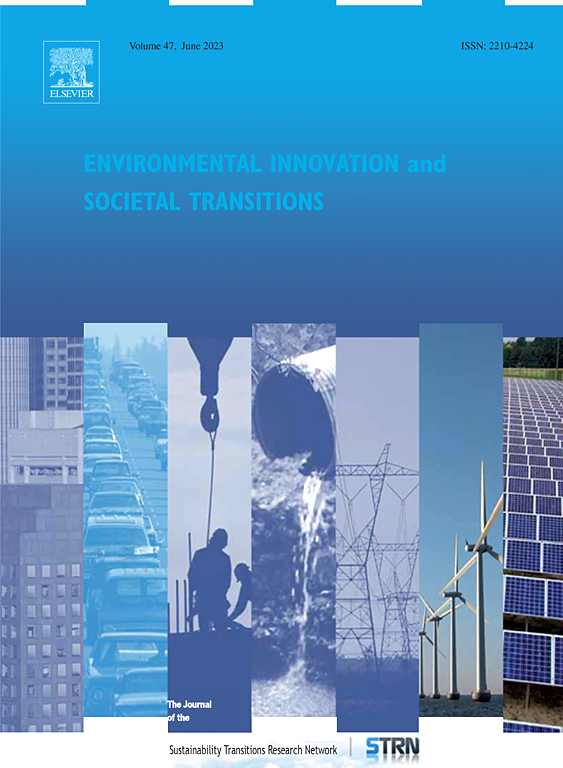海事技术关注趋势:流行语、稳定性和新兴模式
IF 6.1
2区 经济学
Q1 ENVIRONMENTAL SCIENCES
Environmental Innovation and Societal Transitions
Pub Date : 2025-08-28
DOI:10.1016/j.eist.2025.101035
引用次数: 0
摘要
本文通过对海事技术中短暂流行语和持续技术趋势的注意模式分析,进行了系统的文献综述(SLR)。利用来自学术出版物、行业新闻和欧盟资助项目的时间数据,我们确定了塑造该行业技术话语的关键趋势。我们的研究结果表明,替代燃料、绿色推进、脱碳、电气化和自动化得到了研究、政策和行业的持续关注,凸显了它们的长期相关性。人工智能(AI)和智能港口表现出稳定的势头,尽管政策参与落后于行业采用。绿色港口稳步增长,反映了基础设施现代化的挑战。自动识别系统(AIS)仍然作为一种成熟的技术而不是新兴的趋势而被广泛讨论。相比之下,区块链和物联网(IoT)遵循炒作周期,经历了急剧的关注高峰,然后下降。大数据和云计算虽然仍在使用,但已经从广泛的讨论过渡到专门的应用,减少了它们在更广泛讨论中的重要性。数字孪生保持了研究兴趣,但面临缓慢的行业吸收,而港口社区系统(PCS)和同步模式显示不一致的注意力模式,表明早期发展。该分析提供了关于海事技术如何随着时间的推移而获得和保持关注的见解,帮助研究人员、政策制定者和行业利益相关者区分海事创新的短暂炒作和变革趋势。本文章由计算机程序翻译,如有差异,请以英文原文为准。
Maritime technology attention trends: Buzzwords, stability, and emerging patterns
This paper presents a systematic literature review (SLR) to differentiate between transient buzzwords and sustained technological trends in maritime technology by analyzing attention patterns over time. Using temporal data from academic publications, industry news, and EU-funded projects, we identify key trends shaping the sector’s technological discourse. Our findings indicate that alternative fuels, green propulsion, decarbonization, electrification, and automation receive sustained attention across research, policy, and industry, highlighting their long-term relevance. Artificial intelligence (AI) and smart ports demonstrate stable momentum, though policy engagement lags behind industry adoption. Green ports exhibit steady growth, reflecting challenges in infrastructure modernization. Automated identification system (AIS) Automated identification system (AIS)1 remains widely discussed as an established technology rather than an emerging trend. In contrast, blockchain and internet of things (IoT) follow hype cycles, experiencing sharp attention spikes before declining. Big data and cloud computing, while still in use, have transitioned from broad discussions to specialized applications, reducing their prominence in wider discourse. Digital twins sustain research interest but face slow industry uptake, while Port Community Systems (PCS) and synchromodality display inconsistent attention patterns, suggesting early-stage development. This analysis provides insights into how maritime technologies gain and sustain attention over time, helping researchers, policymakers, and industry stakeholders distinguish between fleeting hype and transformative trends in maritime innovation.
求助全文
通过发布文献求助,成功后即可免费获取论文全文。
去求助
来源期刊

Environmental Innovation and Societal Transitions
Energy-Renewable Energy, Sustainability and the Environment
CiteScore
13.60
自引率
19.40%
发文量
90
审稿时长
56 days
期刊介绍:
Environmental Innovation and Societal Transitions serves as a platform for reporting studies on innovations and socio-economic transitions aimed at fostering an environmentally sustainable economy, thereby addressing structural resource scarcity and environmental challenges, particularly those associated with fossil energy use and climate change. The journal focuses on various forms of innovation, including technological, organizational, economic, institutional, and political, as well as economy-wide and sectoral changes in areas such as energy, transport, agriculture, and water management. It endeavors to tackle complex questions concerning social, economic, behavioral-psychological, and political barriers and opportunities, along with their intricate interactions. With a multidisciplinary approach and methodological openness, the journal welcomes contributions from a wide array of disciplines within the social, environmental, and innovation sciences.
 求助内容:
求助内容: 应助结果提醒方式:
应助结果提醒方式:


